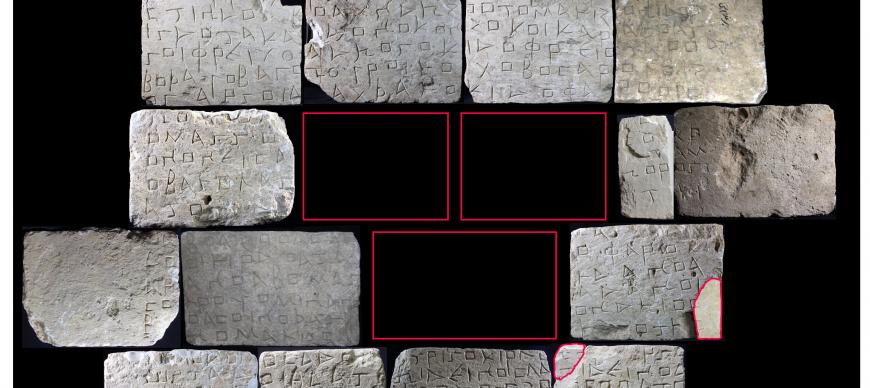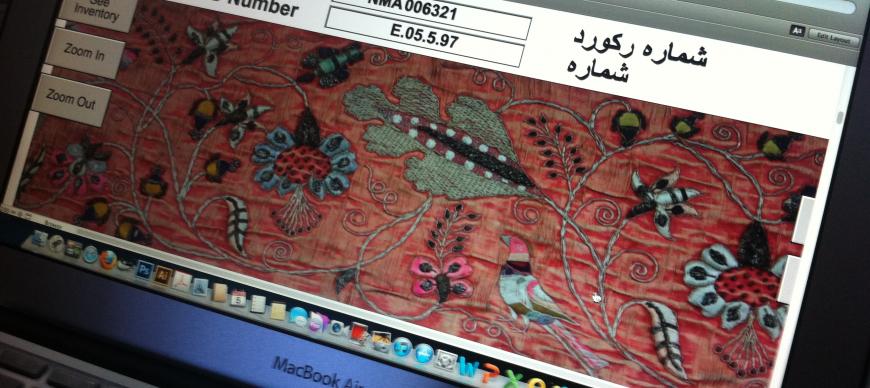New Book Published! A History of Afghanistan in 100 Objects. For the English version - click here for the Single Pages and here for the ePUB. Click here for the Dari translation.
Afghanistan is the quintessential “crossroads of cultures” where the civilizations of the Near East, Central Asia, South Asia and China interacted over the millennia in a constantly shifting mixture of trade, cultural borrowings, migration, imperial conquests, and periodic conflict. This complex history of contacts gave rise to some of the most important archaeological, artistic, architectural, and textual treasures in world cultural heritage – encompassing cultures as diverse as the Bronze Age cities of Bactria, the Persian Empire, the easternmost colonies founded by Alexander the Great and his Hellenistic successors, the Kushan empire astride the Silk Road, the monumental Buddhas of Bamiyan, and the Timurid masterpieces of late medieval Islamic architecture in Herat.
Tragically, the cultural heritage of Afghanistan has been devastated by four decades of continuous war from the Soviet invasion of 1979 and continuing up to the present. The National Museum of Afghanistan — the most important repository of cultural heritage in that country — was devastated in this conflict. An estimated 70% of the objects were looted, while 90% of the object registration records were destroyed.
Since 2012, the Institute for the Study of Ancient Cultures (ISAC) has been carrying four major projects of cultural heritage preservation in Afghanistan, supported by major grants from the US Department of State through the American Embassy in Kabul:
- The National Museum of Afghanistan-Institute for the Study of Ancient Cultures (NMA-ISAC) Partnership
- The Afghan Heritage Mapping Project (AHMP)
- The Core Operations Infrastructure Grant
- The Mobile Museum Outreach Project
These projects are under the direction of Prof. Gil Stein (Principal Investigator), with administrative support from Brendan Bulger (ISAC Program Administrator) and conservation assistance by Laura D’Alessandro and Alison Whyte from the ISAC Museum. The Program Field Director in Afghanistan is Alejandro Gallego Lopez, while our head conservator in Kabul is Fabio Colombo. Our work in Kabul takes place thanks to the support of our colleagues at the US Department of State Dr. Laura Tedesco, Grachelle Javellana and Vitessa del Prete.
Publications of the ISAC Cultural Heritage Preservation Work in Afghanistan can be found in ISAC's annual reports (from 2012 to the present), in the ISAC member magazine News & Notes, and in a number of peer reviewed journals.
The NMA-ISAC Partnership is helping to rebuild the National Museum by working with its staff in five key areas:
- Development of a bilingual Dari-English objects management database
- Implementation of the first full inventory of the NMA’s collections
- Conservation assessments for the museum’s objects,
- Rehousing the NMA’s objects in archival quality containers,
- Training the NMA staff in conservation, database management, and artifact curation.
The Afghan Heritage Mapping Project (AHMP) uses remote sensing satellite imagery to develop a geospatial database of all detectable archaeological sites in Afghanistan. The 4 main goals of the project are:
- GIS-based documentation of all archaeological sites in Afghanistan
- Monitoring sites for evidence of looting,
- Development of the GIS geospatial database as a planning tool that will allow heritage protection to be incorporated into mining, economic, and urban development projects.
- Technical training and capacity building
The Core Operations Grant develops and supports the basic infrastructure of the National Museum of Afghanistan, heritage management units in the Ministry of Information and Culture, and ISAC's Kabul team whose work crosscuts all of the projects described above. One of the most important infrastructure developments taking place as part of the Core Operations program is the Hadda Sculptural Restoration Project. This project seeks to re-assemble and restore an estimated 250-300 Gandharan style sculptures from the early Buddhist monastery sites at Hadda, near the Khyber Pass in southeast Afghanistan. These 1500 year old sculptures were systematically sledge-hammered into pieces by the Taliban in 2001.
The Mobile Museum Outreach Project is developing the first national-scale program of outreach education to raise awareness of the National Museum among high school students in six cities across Afghanistan through in-class presentations in twenty-four schools in Kabul, Herat, Mazar-I Sharif, Bamiyan, Kandahar, and Jalalabad. Presentation materials will also be made at five of the US Embassy’s Lincoln Learning Centers across the country, and at two orphanages in Herat.
Bibliography of Publications arising from ISAC Cultural Heritage Preservation Projects in Afghanistan:
Stein, Gil; Gallego Lopez, Alejandro; and M. Fahim Rahimi
2022. “A History of Afghanistan in 100 Objects. Treasures from the National Museum of Afghanistan. London, UK, Scala Arts and Heritage Publishers, Ltd.” Download PDF
Fisher, Michael T.
2017. “Partnership for Preservation: The Digital Inventory of the National Museum of Afghanistan.” In Stein, Gil J., Michael T. Fisher, Abdul Hafiz Latify, Najibullah Popal, and Nancy Hatch Dupree, (eds.) Preserving the Cultural Heritage of Afghanistan. Proceedings of the International Conference held at Kabul University, November 2014, pp 43–48. Chicago: Oriental Institute Publications. Download PDF
Fisher, Michael T. and Gil J. Stein
2016. “Aks of War: A Digital Museum inventory for a War-torn Afghanistan.” Proceedings 9th ICAANE, Basel 2014, pp 453–467. Basel. Download PDF
Fisher, Michael T. and Matthew Stolper
2015. “Achaemenid Elamite Administrative Tablets, 3: Fragments from Old Kandahar, Afghanistan.” Arta 2015.001. Download PDF
Franklin, Kathryn and Emily Boak
2019. “The road from above: Remotely sensed discovery of early modern travel infrastructure in Afghanistan.” Archaeological Research in Asia. https://doi.org/10.1016/j.ara.2019.02.002. Download PDF
Franklin, Kathryn and Emily Hammer
2018. “Untangling Palimpsest Landscapes in Conflict Zones: A “Remote Survey" in Spin Boldak, Southeast Afghanistan.” Journal of Field Archaeology https://doi.org/10.1080/00934690.2017.1414522. Download PDF
Hakimzada, Abdullah and Laura d’Alessandro
2017. “Conservation in Afghanistan.” In: Stein, Gil J., Michael T. Fisher, Abdul Hafiz Latify, Najibullah Popal, and Nancy Hatch Dupree (eds.) Preserving the Cultural Heritage of Afghanistan. Proceedings of the International Conference held at Kabul University, November 2014, pp 117–122. Chicago: Oriental Institute Publications. Download PDF
Hammer, Emily; Rebecca Seifriedb, Kathryn Franklinc, Anthony Lauricella
2017. "Remote assessments of the archaeological heritage situation in Afghanistan.” Journal of Cultural Heritage https://doi.org/10.1016/j.culher.2017.12.008. Download PDF
Kristy, Gwendolyn
2018. "The impact of urban sprawl on cultural heritage in Herat, Afghanitan: A GIS analysis." Digital Applications in Archaeology and Cultural Heritage, https://doi.org/10.1016/j.daach.2018.e00086. Download PDF
Lauricella, Anthony; Joshua Cannon, Scott Branting and Emily Hammer
2017. "Semi-automated detection of looting in Afghanistan using multispectral imagery and principal component analysis” Antiquity 91 (359): 1344–1355.
Stein, Gil J.
2012. “The Oriental Institute-National Museum of Afghanistan Partnership.” Oriental Institute Annual Report 2011–2012, pp 123–130. Chicago: Oriental Institute Publications. Download PDF
2013. “The Oriental Institute-National Museum of Afghanistan Partnership.” Oriental Institute Annual Report 2012–2013, pp 87–95. Chicago: Oriental Institute Publications. Download PDF
2014. “The Oriental Institute-National Museum of Afghanistan Partnership and Cultural Heritage Protection Work: 2013–2014 Report.” Oriental Institute Annual Report 2013–2014, pp 113–121. Chicago: Oriental Institute Publications. Download PDF
2015. “Preserving the Cultural Heritage of Afghanistan - International Conference in Kabul, November 2014.” Oriental Institute News & Notes no. 225 (Spring 2015): 10–13. Chicago: Oriental Institute Publications. Download PDF
2015. “The Oriental Institute Partnership with the National Museum of Afghanistan 2014–2015 Report.” Oriental Institute Annual Report 2014–2015, pp 139–143. Chicago: Oriental Institute Publications. Download PDF
2015. “The war-ravaged archaeological heritage of Afghanistan: An overview of projects of assessment, mitigation, and preservation.” Near Eastern Archaeology 2015 vol. 78 (3): 187–195. Download PDF
2016. “The Oriental Institute Partnership with the National Museum of Afghanistan 2015–2016 Report.” Oriental Institute Annual Report 2015–2016, pp 130–135. Chicago: Oriental Institute Publications. Download PDF
2017. ”The Oriental Institute Partnership with the National Museum of Afghanistan” Oriental Institute Annual Report 2016–2017, pp 143–150. Chicago: Oriental Institute Publications. Download PDF
2018. “Oriental Institute Cultural Heritage work in Afghanistan.” Oriental Institute Annual Report 2017–2018, pp 115–121. Chicago: Oriental Institute Publications.
Stein, Gil J., Michael T. Fisher, Abdul Hafiz Latify, Najibullah Popal, and Nancy Hatch Dupree (eds.)
2017. Preserving the Cultural Heritage of Afghanistan. Proceedings of the International Conference held at Kabul University, November 2014. Chicago: Oriental Institute Publications. Download PDF
Stein, Gil J., Alejandro Gallego Lopez, Michael T. Fisher, and Fahim Rahimi
2018. "Tracking Down Missing Treasures from the National Museum of Afghanistan.” Oriental Institute News & Notes 238 (Summer 2018): 14–16. Download PDF




